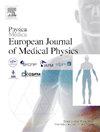Evaluation of a modified formalism for precision electron beam dosimetry compared to TG-51 and TRS-398
IF 3.3
3区 医学
Q1 RADIOLOGY, NUCLEAR MEDICINE & MEDICAL IMAGING
Physica Medica-European Journal of Medical Physics
Pub Date : 2025-02-01
DOI:10.1016/j.ejmp.2025.104905
引用次数: 0
Abstract
Purpose
This study aims to evaluate a modified formalism for electron beam reference dosimetry and to compare the results with the cases of previous protocols TG-51 and TRS-398.
Methods
Measurements were performed using three types of cylindrical chambers (TW30013, FC65-G, and A1SL) and plane-parallel chambers (PPC) (Roos, Advanced Markus, and NACP-02) with electron beams of energies 6, 12, and 18 MeV. Absorbed dose to water at the reference depths was determined following the modified formalism using different chambers and methods, including the direct application of 60Co calibration or cross-calibration for PPCs in a high-energy electron beam. Data were also analyzed following TG-51 and TRS-398 formalisms for comparison.
Results
Following the modified formalism, all the results obtained using cylindrical chambers, 60Co calibrated well-guarded PPCs and cross-calibrated PPCs were in good agreement within the estimated uncertainty (0.7 – 0.9 %) at all the energies. However, one PPC exhibited strange behavior, producing 3 % higher doses when applying 60Co calibration. This was confirmed due to chamber-to-chamber variation in Pwall.
The modified formalism showed good agreement with TG-51 and TRS-398, but yielded consistently higher doses. The difference was reduced by applying the updated EPOM (effective point of measurement) shift to the previous protocols.
Conclusions
This study supports the reliability of the modified formalism for electron beam reference dosimetry with chambers calibrated under 60Co, thereby reducing uncertainty. The modified formalism yielded consistent results within smaller uncertainty (0.7 – 0.9 %). However, it is recommended to check each PPC’s chamber-to-chamber variation.
求助全文
约1分钟内获得全文
求助全文
来源期刊
CiteScore
6.80
自引率
14.70%
发文量
493
审稿时长
78 days
期刊介绍:
Physica Medica, European Journal of Medical Physics, publishing with Elsevier from 2007, provides an international forum for research and reviews on the following main topics:
Medical Imaging
Radiation Therapy
Radiation Protection
Measuring Systems and Signal Processing
Education and training in Medical Physics
Professional issues in Medical Physics.

 求助内容:
求助内容: 应助结果提醒方式:
应助结果提醒方式:


